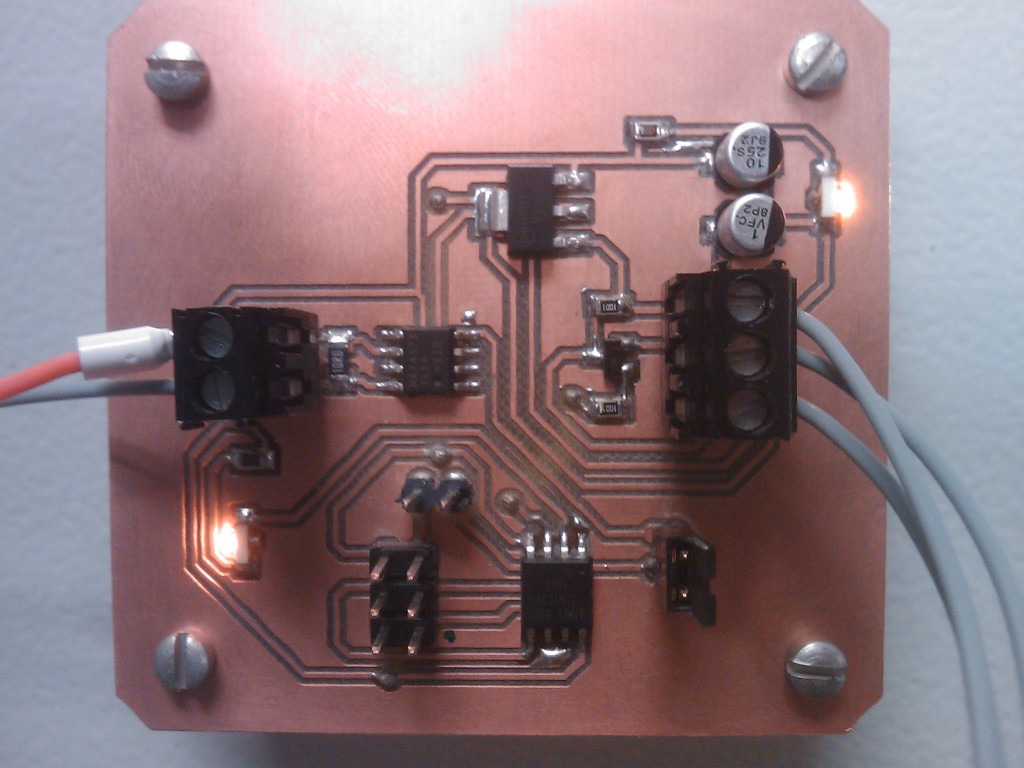MAX4173 Current sense amplifier
I just built a current sensing application based on a MAX4173. I am suitably impressed with this device. It is extremely versatile and cheap. The MAX4173 allows you to measure the current across a sense resistor with a 28V common-mode range and provides a ground-referenced output proportional to the current across the resistor. I will probably be using one on most of my projects from now on since I do a lot of prototype work and having a cheap and easy way to sense current draw is pretty useful.

The MAX4173 is available in either an SOT23 or SO8 package, and only requires a decoupling capacitor and a sense resistor to operate. There are three different preset gains available so by combining that with the sense resistor value you can achieve a variety of current ranges.
I used the device in a 4-20mA control loop, with a 20X gain and a 10Ω resistor for a 0.8-4V output into an ATtiny 13’s ADC with a 5V reference. The 10Ω sense resistor is small enough that the loop won’t be affected and large enough to provide good signal range and sensitivity.
For future projects I will probably be using the higher gain version with a smaller sense resistor on the input power line and just leave the MAX4173 output on a header for diagnostic measurement if I don’t have a spare ADC pin. This will limit circuit loading but provide an output for measuring actual circuit current draw.
There is another similar version of the MAX4173, the MAX4080. It can handle higher common-mode voltages and bidirectional current. It’s also a bit more accurate than the 4173, but I haven’t tried it out yet.
5 Comments to MAX4173 Current sense amplifier
Leave a Reply
Other Stuff
Recent Posts
- 6CY7 dual triode valve amplifier
- Air quality sensor (TVOC and eqCO2)
- Automotive rear fill “surround sound” with Boss DD-3
- Spring tester / weight scale
- Ducati 749/999 Tail Light
- Instruments for the GSXR
- Light pipe tail light for the GSXR
- M17x 6990m / 6970m overheating
- PAR / Spectrum analyzer
- Acrylic polishing and scratch removal
Archives
- May 2019 (2)
- April 2017 (3)
- October 2015 (1)
- May 2015 (1)
- March 2014 (2)
- December 2013 (1)
- July 2013 (1)
- November 2012 (1)
- October 2012 (4)
- September 2012 (1)
- August 2012 (3)
- June 2012 (1)
- March 2012 (1)
- February 2012 (1)
- January 2012 (1)
- October 2011 (3)
- July 2011 (1)
- June 2011 (3)
- May 2011 (2)
- April 2011 (1)
- December 2010 (1)
- August 2010 (1)
- July 2010 (3)
- April 2010 (2)
- March 2010 (2)
- January 2010 (2)
- December 2009 (2)
- October 2009 (2)
- September 2009 (1)
- August 2009 (15)
Thanks josh for the wonderful work and i did sent you a mail with starting id richmondbode thanks
Hi, Mr.Josh, i want to say thak you for the helpfull device and i want to ask where have you bought the MAX4173? because i want to bay one in the U.S, but i could not find a saler exapt for Jameco company. So, please if you know someone else how dose let me know.
Best regards.
Abdulaziz
Aziz-4-4-4-@hotmail.com
Abdulaziz, I got the MAX4173 directly from Maxim. You can order samples from their website.
http://www.maxim-ic.com/samples/
Hey Mr. Josh. I am using the MAX4173 for my solar panel project. We are trying to measure and display the voltage and current the solar panel generates. We can successfully measured the voltage but can not measure the current. We are trying to use the MAX4173 to measure the current but I am not sure how it works. Can you please explain ? Does the chip output the exact current through Rsense or the current specified by the datasheet ? Thank you
Hi Daddi, it’s been quite a while since I worked with that chip, but it’s basically an amplifier. You put the sense resistor in series with the colar panel, and the resistance of the resistor causes a voltage drop that is proportional to current. You use a small resisitor so as to limit the effect on the circuit. Then the chip measures the voltage drop, and buffers and amplifies it for use. You decide what the output is based on how you set up the chip. The datasheet can tell you more about how to do it. Good luck!